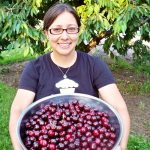By Ken Lain, the mountain gardener
Most tree fruits release a sweet scent into the air when their fruits are ready to taste, but it’s very hard to gauge the exact moment of peak ripeness. Times will vary year by year and different varieties will “come in” at different times. Here, by fruit variety, are a few signs that indicate ripeness.
Apples – You might have heard that ripening apples give off the hormone ethylene gas.  One of its effects is to cause the separation of the stem from the tree, causing the apples to fall. It is not the best test for ripeness.
One of its effects is to cause the separation of the stem from the tree, causing the apples to fall. It is not the best test for ripeness.
Many apple varieties are ready when you can easily pull them from the tree. Don’t yank. Grasp gently and give them a slight twist.
Another way to tell is by looking at the seeds. When the seeds turn brown the fruit has hit its peak taste.
I still maintain that the best test is to bite into an apple. Too starchy and tart means it’s under ripe. Pithy or mealy means it’s over ripe. Simply enough, an apple should be juicy and sweet.
Pears – Pears should be picked when just starting to change color from green to a tinge of yellow. At this point, the fruits will still be hard, but easily pull away from the tree. Give them a few days to a few weeks to continue ripening once they’re off the tree.
Allowing pears to fully ripen on the tree produces fruit that have a gritty texture and quickly go to mush.
Stone Fruits – For fresh eating, allow them to ripen fully on the tree. Most will not continue ripening or sweetening post harvest. You’ve probably had some flavorless, limpid peaches or cherries from the grocery store that were picked when immature and, consequently, softened in shipping.
or cherries from the grocery store that were picked when immature and, consequently, softened in shipping.
If you plan to can or freeze stone fruits, pick them a little on the firm side. They will soften more with processing and you probably will be adding sugar, which will compensate for any loss of natural sweetening.
Stone fruits are ripe when they look fully colored and the flesh has started to soften slightly to the touch. The only true test though, is by taste. Stone fruits don’t store well, so enjoy them while you can!
Grapes and Citrus – These fruits stop ripening when they are picked. For juicy, sweet flavor, they need to be completely ripe before harvesting and ripening can take months. It’s hard to tell ripeness by touch and, once again, the best test is by taste.
Citrus does not separate from the tree easily and, rather than pulling, I recommend cutting these fruits from their branches.
General Harvesting Tips
Use caution when eating fruit that has fallen from the tree. Fruits sometimes drop from trees because they are infested, so check before you munch down on a fruit full of worms.
Be gentle. Don’t tug and tear the stem off soft fruits like strawberries, cherries, and even  tomatoes; you may injure the stem end, which is an invitation for rot.
tomatoes; you may injure the stem end, which is an invitation for rot.
Don’t toss fruits into your basket or container, and don’t pile them so high that top layers crush the fruits underneath. To prevent the mess of staining from juice running out of your container, before harvesting line it with a layer of paper towels.
Don’t leave fruits on the tree or lying on the ground. This will cut down on the chance of disease or pests from overwintering.
For the best flavor, freshly harvested fruits should be stored at room temperature. But if your taster is like mine, you’ll trade a little flavor for the exhilaration of biting into an icy cold piece of fruit!
Until next week, I’ll see you in the garden center.
Ken Lain can be found throughout the week at Watters Garden Center, 1815 W. Iron Springs Rd in Prescott, or contacted through his web site at WattersGardenCenter.com or FB.com/WattersGardenCenter .

